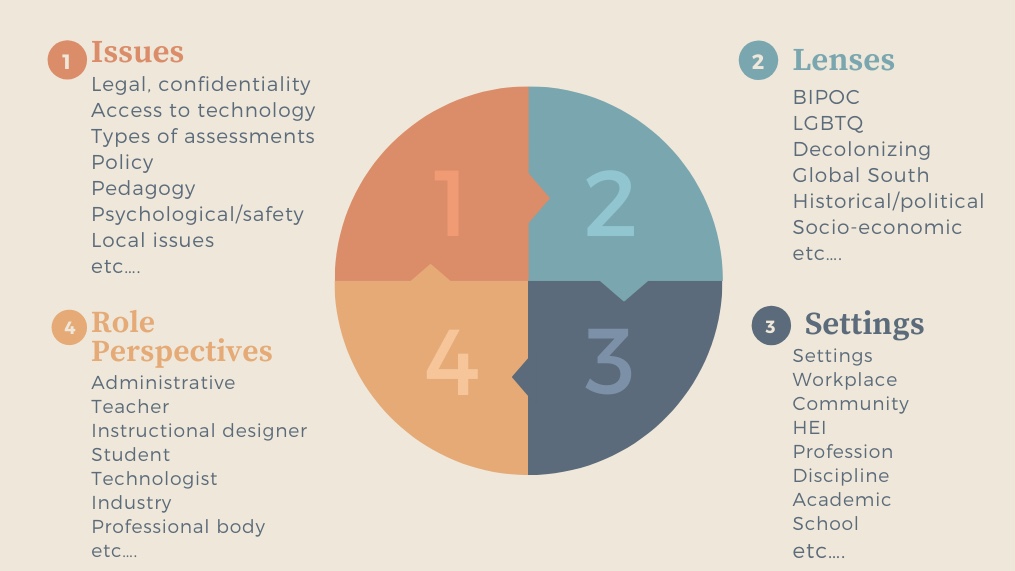Co-creating Places for Learning

When a person walks into their home, they likely feel an instant sense of familiarity and connection. In contrast, walking into a doctor’s office, a library, or a classroom may invoke very different feelings in individuals because of multiple influences including the way the space is set up and the individual’s lived experiences, culture, and background. For example, think about how the images of the spaces illustrated below make you feel.
It is easy to think about the design of a space when we think of a physical environment – for example, one can select colors and objects and adjust light and sound to invoke a particular feel or mood. However, it is more difficult to apply these ideas directly when we think about online spaces. Take the examples below, which both represent a screen within an online course. A viewer or student may experience very different emotions when viewing the primarily text-based screen on the left, versus the more image-based and colorful screen on the right.
In this case, much like physical spaces, instructors and designers can adjust some properties like color and sound to inspire a specific feeling or mood, but other design features may be primarily determined by software developers and/or educational administrators. However, in general, when we think about the design of online learning, the focus tends to be on content sequencing and media integration, with much less attention to sensations or feelings invoked by the online spaces.
How do we design for place in online learning?
When we talk about space, we generally refer to coordinates of a location or characteristics that define the geometry or form of a location. Instead, the word place connotes a personalized sense of belonging or relating to a particular context (Agnew, 2011). The design of a space has social, physical, and emotional implications for how users of the space engage with each other and the content therein (Oblinger, 2006). Thus, when we think about designing for online learning, we should think about creating a space as well as a place to encourage learning, belonging, and personalization. Much of formal online learning is facilitated by an instructor via a learning management system (LMS) like Canvas, Blackboard, or Moodle since these tools allow easy integration with administrative functions. But, they can be highly structured and inflexible in design and may not offer an easy way to give control to students in designing a place for themselves.
Configuring the ‘physical’ space
While an LMS might be central for an online course, one possibility is to add additional tools to allow student customization. For example, blogs are a popular and easily available tool for student writing. Blogs can be used in various ways to support student expression and can be easily integrated into formal learning settings. In one of my classes, for example, instead of only using an LMS, I have integrated blogs as part of the course environment. While students access course-related content from the LMS, I encourage their individual writing to be housed in their personal blogs. Using blogs provides a level of personalization in the look and feel of each student’s expression—i.e., they can customize colors, layouts, and designs, and integrate media as they choose to support their writing and ideas. At the same time, blogging supports a more unstructured, organic, and personalized form of writing (Zhang, 2010) that students have consistently appreciated. In the course, students blog and read each other’s blogs every week so they are exposed to different viewpoints and ideas.
But we can also think about space as a networked concept (Nordquist & Laing, 2015) which includes several interlinked virtual spaces that connect outside the immediate classroom context. For example, this article identifies different ways to use Twitter to engage students with others outside the classroom while this blog post suggests different ways to use Instagram to share student work and thinking. Linking multiple spaces provides options to connect course participants with outside viewpoints and reach an authentic audience and broaden our understanding of the place and space.
However, while an instructor can easily make such design decisions, how can we push toward co-creating a place of learning? What does that mean? In what ways can we invite all participants in an online course (students and facilitators) alike to suggest online spaces that can be configured together into a digital place of learning that allows for participants to have some ownership and control over the physical aspects of the space? What might we need to consider in making this type of design possible? What challenges and opportunities might arise in such an endeavor?
At the end of this reading you may want to revisit the above questions using the provided perspective framework and choose a lens to further explore these ideas.
Configuring the ‘social’ space
To return to our metaphor of physical structures and spaces, a building usually has designed spaces for private and public gatherings as well as interaction. A home, for example, might have a common kitchen, dining, or living area, and private spaces like bathrooms and bedrooms. In contrast, in a school, while all spaces are public, some areas like the cafeteria, the playground, the student center, or the hallways might be more conducive to social interaction.
In online learning spaces, social interaction is usually tied to learning content – e.g., setting up discussion boards to discuss instructional material. While the use of different media to engage around content is useful, we should consider that there may be no spaces or places where students can go to interact socially around an idea or topic of interest that may not be related to course content or that we need to design socially supportive environments by allowing students time to create those relationships (Downing et al., 2007). This blog post offers some ideas on how to create virtual social spaces in education, while this post offers suggestions on how to create informal interaction spaces in training programs.
As an example, in my course, I also use Slack, a team-based collaborative application that is widely used in corporate settings but can also be used in education. Slack has a variety of features that provide the type of instant social gathering space that could be helpful to create a sense of belonging, thus creating a place for learning. In my course, while students use blogs as their own customizable private place for documenting thoughts and ideas, I encourage them to interact on Slack for their weekly discussions. Slack offers options to use various media types and integrate emojis and other social media features to allow a broader range of expression and engagement than just text.
But how do we support the co-creation of social places? For example, in what ways can we invite all participants to contribute and take ownership of the creation, organization, and maintenance of such a social place? Can social contracts for interaction be generated together? How do we create a safe social place together? What are the challenges and opportunities of creating a shared, safe, social place for interaction?
At the end of this reading you may want to revisit the above questions using the provided perspective framework and choose a lens to further explore these ideas.
Configuring the ‘emotional’ space
The last important aspect of configuring place versus space is addressing the emotional aspects which are an integral part of learning (Cleveland-Innes & Campbell, 2012). This, however, may be one of the most challenging aspects of design and co-creation. Every participant in a course comes in with different experiences, backgrounds, and perspectives. Inviting these participants to engage and feel emotionally connected within the online space is important as identified by this blog post, which also describes some strategies to increase connection within the course. Apart from providing opportunities to interact, we should also consider the design of the space to be inclusive (allowing space to display pronouns, for example) and accessible (to accommodate for different abilities).
Another aspect of having students feel emotionally engaged is to allow some ownership and choice in what they do in the course. When possible, for example, giving students control over the choice of project and context, or being flexible in how they choose to demonstrate their learning, can result in a sense of engagement and ownership. In the course I have used as an example for this piece, students can pick a final project related to their context and can pick a different mode of weekly reflection – instead of blogging, they could choose to record a podcast, or create a vlog, or any other form of representation that is most helpful to their learning.
However, creating these emotional places is a delicate process requiring time and input from various sources. How do we solicit input from course participants about what kinds of designs or choices impact their sense of emotional engagement to create a place? What challenges and opportunities might we face as part of this process?
Concluding thoughts
While the words space and place are often used interchangeably, as educators we want to create places of engagement, belonging, and interaction that span both physical and virtual environments. Architects and designers have spent many years thinking about and studying the impact of different design features in creating physical places. As more of our interactions, educational or otherwise, move online we have yet to appreciate the many design features that can create a virtual place rather than primarily a virtual space.
Activity
As highlighted throughout this reading, creating a sense of place in our online learning environments can be challenging. Consider the reflective questions that have been posed throughout and choose one or all types of place – physical (or material), social, and or emotional and think about how you might address it in your design.
The following figure outlines a “perspective framework” that highlights four different elements: Issues, settings, lenses, and role perspectives that might help you identify alternative views or contexts where you can think about creating places for learning. Choose one or more of the different elements and use those to help shift your thinking or approach creating a sense of place from a different angle. Create a short post on this page, by choosing one of the main elements, that will then form part of this new iteration of an emerging open textbook. You may use media other than text, such as audio, video or other.

References
Agnew, J. A. (2011). Space and Place. In J. A. Agnew & D. N. Livingstone (Eds.), The SAGE Handbook of Geographical Knowledge (pp. 316–330). Sage Publications. https://dx.doi.org/10.4135/9781446201091.n24
Cleveland-Innes, M., & Campbell, P. (2012). Emotional presence, learning, and the online learning environment. The International Review of Research in Open and Distance Learning, 13(4), 269–292. https://doi.org/10.19173/irrodl.v13i4.1234
Downing, K., Lam, T., Kwong, T., Downing, W., & Chan, S. (2007) Creating interaction in online learning: a case study, ALT-J, 15:3, 201-215, DOI: 10.1080/09687760701673592
Nordquist, J., & Laing, A. (2015). Designing spaces for the networked learning landscape. Medical Teacher, 37(4), 337–343. https://doi.org/10.3109/0142159X.2014.1001349
Oblinger, D. G. (2006). Learning Spaces. In British Journal of Educational Technology (Vol. 41). https://doi.org/10.1111/j.1467-8535.2009.00974.x
Zhang, W. (2010). Blogging for Doing English Digital: Student evaluations. Computers and Education 27(4), pp. 266-283. https://doi.org/10.1016/j.compcom.2010.09.003




